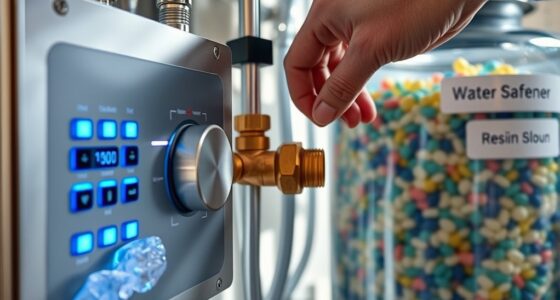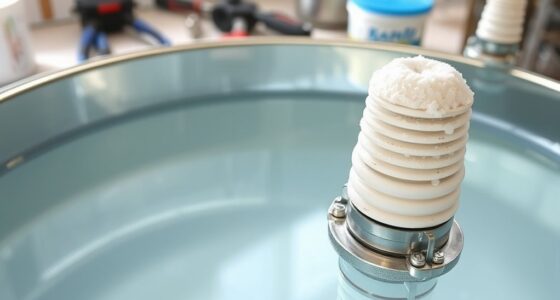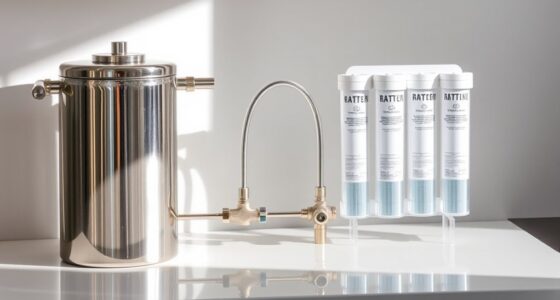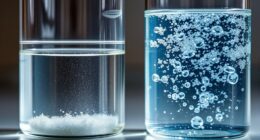Water softeners use ion exchange to remove minerals like calcium and magnesium that cause scale buildup. Water flows through a resin bed coated with sodium or potassium ions; these minerals are attracted to the resin and swap places with the harmless ions. Over time, the resin gets overwhelmed. A salt solution then flushes the minerals away and recharges the beads. If you stay tuned, you’ll discover how this process keeps your plumbing running smoothly and efficiently.
Key Takeaways
- Water softeners use ion exchange to replace calcium and magnesium with sodium or potassium ions.
- Water flows through resin beads that attract and hold scale-forming minerals.
- Over time, resin beads become saturated and are regenerated using a salt brine solution.
- The regeneration cycle displaces minerals from the resin, washing them away and recharging beads.
- Automatic control valves ensure continuous softening by initiating regeneration as needed.

Water softeners are devices that remove minerals like calcium and magnesium from your water supply, preventing common problems caused by hard water. These minerals cause scale buildup in pipes, appliances, and fixtures, leading to reduced efficiency and increased maintenance costs. To combat this, water softeners rely on a process called ion exchange, which effectively replaces these minerals with sodium or potassium ions, making your water much gentler on your plumbing and appliances.
Water softeners remove calcium and magnesium, preventing scale buildup and protecting plumbing and appliances.
The core of how water softeners work involves mineral exchange. Inside the softener tank, you’ll find a resin bed made up of tiny beads coated with sodium or potassium ions. When hard water flows through the tank, the calcium and magnesium ions in the water are attracted to the resin beads. Because these beads have a stronger affinity for calcium and magnesium than for sodium or potassium, they swap places—hence the term ion exchange. As a result, the harmful minerals are trapped on the resin beads, and the water that exits the tank is softened, free of scale-forming minerals.
Over time, however, the resin beads become overwhelmed with calcium and magnesium ions and need to be regenerated. This is where salt regeneration comes into play. During regeneration, a brine solution containing a high concentration of sodium or potassium chloride is flushed through the resin bed. The high concentration of salt displaces the accumulated calcium and magnesium ions from the resin beads, washing them away down the drain. The beads are then recharged with fresh sodium or potassium ions, ready to repeat the mineral exchange process. This cycle of salt regeneration ensures the resin remains effective and your water stays consistently soft.
The process is automatic in most systems, with the control valve monitoring the resin’s capacity and initiating regeneration when needed. Some systems regenerate based on a timer, while others use a meter to track water usage, regenerating only when necessary. This efficient process means you don’t have to manually intervene, ensuring a continuous supply of softened water without interruption.
In essence, water softeners work by harnessing the natural attraction between minerals and resin beads, swapping out the problematic calcium and magnesium for harmless sodium or potassium ions. The salt regeneration cycle refreshes the resin, maintaining its ability to perform mineral exchange effectively. By understanding this process, you can better appreciate how water softeners keep your water supply free of scale, extending the lifespan of your plumbing and appliances while reducing maintenance hassles.
Frequently Asked Questions
How Often Should I Replace the Resin in My Water Softener?
You should replace the resin in your water softener typically every 10 to 15 years, depending on its resin lifespan and usage. Keep an eye out for signs like reduced softening efficiency or increased salt use, which indicate it’s time for replacement. Regular maintenance and monitoring will help you determine the best replacement frequency, ensuring your softener continues to work effectively and prolongs the resin’s lifespan.
Can Water Softeners Remove All Types of Minerals?
Water softeners mainly remove calcium and magnesium minerals, but they can’t eliminate all types of minerals. Mineral specificity limits their effectiveness; they don’t treat substances like iron, manganese, or certain contaminants. Treatment limitations mean you might need additional filtration systems for specific minerals or impurities. So, while water softeners excel at softening water, they won’t remove every mineral, especially those outside their designed ion exchange process.
Do Water Softeners Require Electricity to Operate?
Ever wonder if your water softener needs electricity? Most models don’t require electricity to operate, making them energy-efficient. They rely on the ion exchange process to remove minerals, so electricity dependency is minimal. However, some advanced systems with digital controls or timers do consume power, increasing overall power consumption. If you want a low-energy option, choose a basic model—are you ready to enjoy softened water without extra energy costs?
What Is the Environmental Impact of Water Softening?
You might be concerned about the environmental impact of water softening. While softeners reduce mineral buildup, they can increase your system’s environmental footprint through chemical discharge and wastewater. The salt-based ion exchange process releases sodium and chloride ions, which may affect local water quality. To minimize this, consider alternative softening methods or use low-salt systems, helping you reduce chemical discharge and lessen your overall environmental impact.
How Long Does a Typical Water Softening Cycle Last?
Imagine your water softener as a diligent worker, tirelessly running its softening duration for about 30 to 90 minutes per cycle. The cycle efficiency depends on your water hardness and system size, ensuring minerals are replaced with sodium ions. During this time, the resin beads refresh, restoring their ability to soften water effectively. You’ll notice softer water, smoother skin, and less soap scum—all thanks to this essential, time-bound process.
Conclusion
Now you know how water softeners work through the wondrous process of ion exchange. By swapping stubborn calcium and magnesium for softer sodium, they save your pipes and appliances from scale. Understanding this simple yet sophisticated system helps you appreciate the power of purification. So, when you see a water softener in action, remember it’s a clever combination of chemistry and craftsmanship, creating clean, clear, and carefree water for your home.









